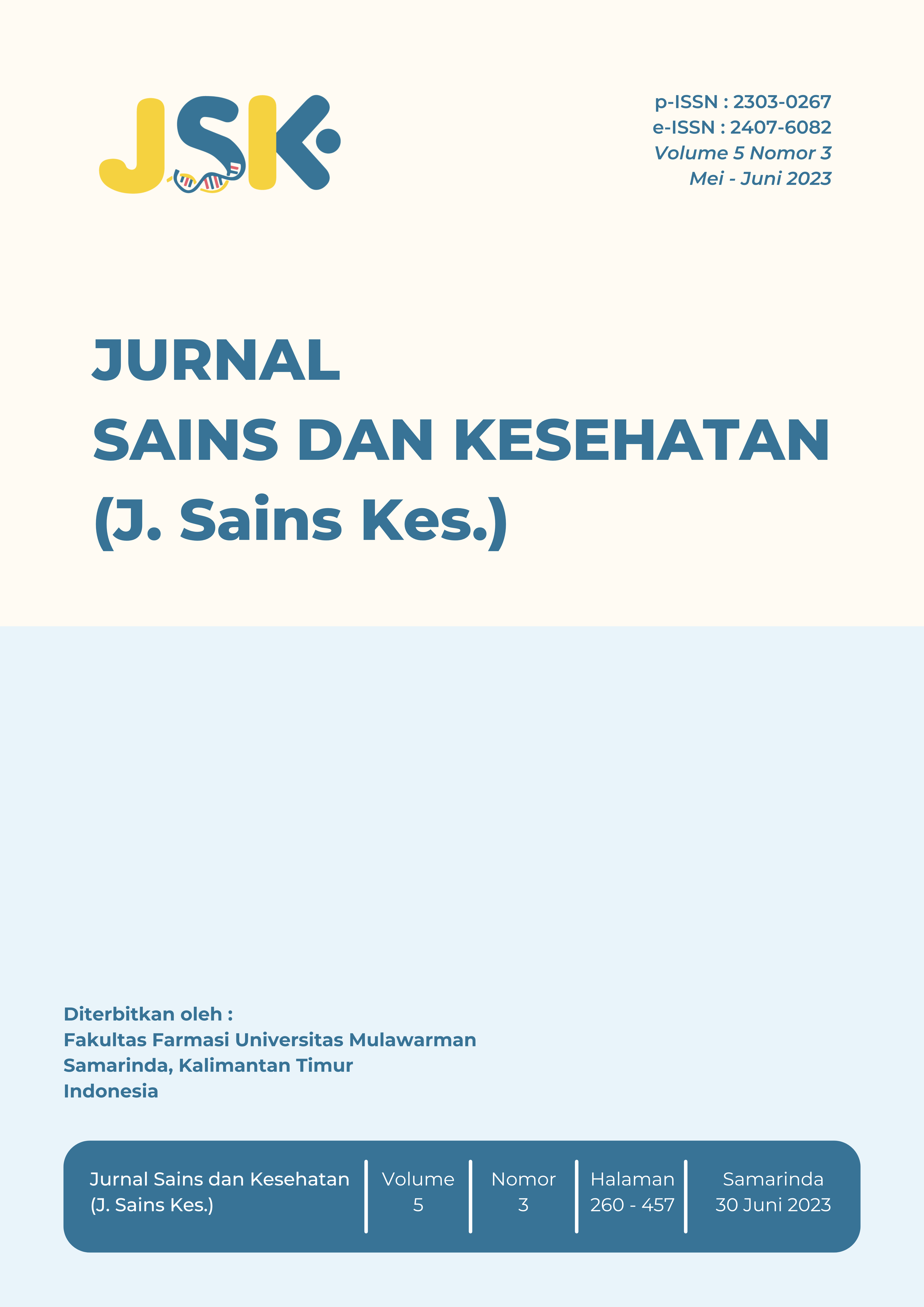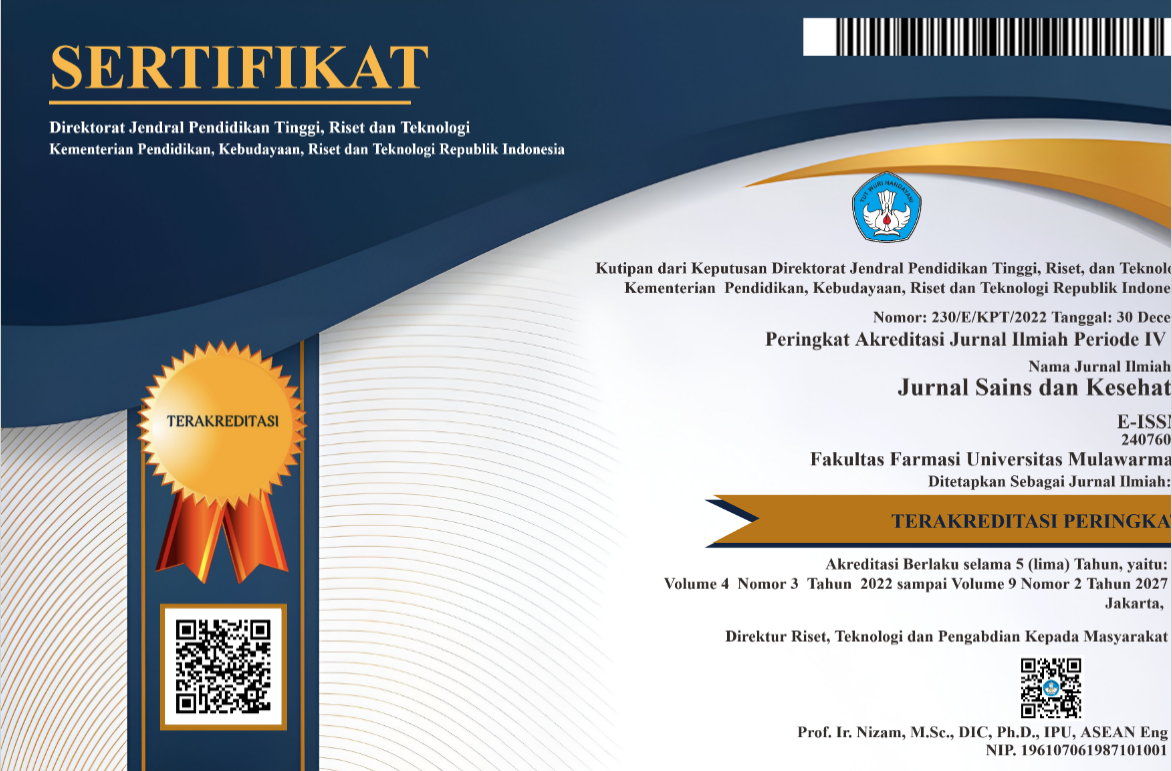Exploring Antifungal Potential of Qusthul Hindi (Saussurea lappa) Root against Candida albicans: A Systematic Review
Keywords:
Saussurea lappa, Qusthul Hindi, Candida albicans, Antifungal ActivityAbstract
References
M. C. Fisher et al., “Threats posed by the fungal kingdom to humans, wildlife, and agriculture,” mBio, vol. 11, no. 3, 2020, doi: 10.1128/MBIO.00449-20/ASSET/6C4AE09A-A3CA-418B-BFCD-09EB1B657093/ASSETS/GRAPHIC/MBIO.00449-20-F0001.JPEG.
R. Wahyuningsih et al., “Serious fungal disease incidence and prevalence in Indonesia,” Mycoses, vol. 64, no. 10, pp. 1203–1212, Oct. 2021, doi: 10.1111/MYC.13304.
S. Silva, C. F. Rodrigues, D. Araújo, M. E. Rodrigues, and M. Henriques, “Candida Species Biofilms’ Antifungal Resistance,” J Fungi (Basel), vol. 3, no. 1, Mar. 2017, doi: 10.3390/JOF3010008.
J. Talapko et al., “Candida albicans-the virulence factors and clinical manifestations of infection,” Journal of Fungi, vol. 7, no. 2, pp. 1–19, Feb. 2021, doi: 10.3390/jof7020079.
M. Bertolini et al., “Candida albicans induces mucosal bacterial dysbiosis that promotes invasive infection,” PLoS Pathog, vol. 15, no. 4, Apr. 2019, doi: 10.1371/JOURNAL.PPAT.1007717.
S. Patil, B. Majumdar, S. C. Sarode, G. S. Sarode, and K. H. Awan, “Oropharyngeal candidosis in HIV-infected patients-an update,” Front Microbiol, vol. 9, no. MAY, p. 980, May 2018, doi: 10.3389/FMICB.2018.00980/BIBTEX.
S. B. Salazar, R. S. Simões, N. A. Pedro, M. J. Pinheiro, M. F. N. N. Carvalho, and N. P. Mira, “An Overview on Conventional and Non-Conventional Therapeutic Approaches for the Treatment of Candidiasis and Underlying Resistance Mechanisms in Clinical Strains,” Journal of Fungi 2020, Vol. 6, Page 23, vol. 6, no. 1, p. 23, Feb. 2020, doi: 10.3390/JOF6010023.
T. M. Karpi?ski, M. O?arowski, A. Seremak-Mrozikiewicz, H. Wolski, and A. Adamczak, “Plant Preparations and Compounds with Activities against Biofilms Formed by Candida spp.,” Journal of Fungi 2021, Vol. 7, Page 360, vol. 7, no. 5, p. 360, May 2021, doi: 10.3390/JOF7050360.
M. F. Soliman et al., “Exploring the Antifungal Activity and Action of Saussurea costus Root Extracts against Candida albicans and Non-albicans Species,” Antibiotics, vol. 11, no. 3, Mar. 2022, doi: 10.3390/antibiotics11030327.
M. Vijayalakshmi, A. Umamaheswari, B. Agalya, S. N. Jegasubramaniam, and S. L. Prabu, “Foresight on Phytoconstituents and Associated Pharmacological Activities of Traditional Medicinal Plant: Saussurea costus (Falc.) Lipschitz,” Current Pharmacology Reports, vol. 8, no. 4. Springer Science and Business Media Deutschland GmbH, pp. 281–289, Aug. 01, 2022. doi: 10.1007/s40495-022-00287-8.
S. I. Abdelwahab et al., “Phytochemical profiling of Costus (Saussurea lappa Clarke) root essential oil, and its antimicrobial and toxicological effects,” Tropical Journal of Pharmaceutical Research, vol. 18, no. 10, pp. 2155–2160, 2019, doi: 10.4314/tjpr.v18i10.22.
H. S. Lee and Y. Kim, “Aucklandia lappa causes membrane permeation of Candida albicans,” J Microbiol Biotechnol, vol. 30, no. 12, pp. 1827–1834, 2021, doi: 10.4014/JMB.2009.09044.
H. S. Lee and Y. Kim, “Aucklandia lappa causes cell wall damage in candida albicans by reducing chitin and (1,3)-?-d-glucan,” J Microbiol Biotechnol, vol. 30, no. 7, pp. 967–973, Jul. 2020, doi: 10.4014/jmb.2002.02025.
N. Khan et al., “Quantification of macro, micro and trace elements, and antimicrobial activity of medicinal herbs and their products,” Arabian Journal of Chemistry, vol. 14, no. 4, Apr. 2021, doi: 10.1016/j.arabjc.2021.103055.
F. A. Alshubaily, “Enhanced antimycotic activity of nanoconjugates from fungal chitosan and Saussurea costus extract against resistant pathogenic Candida strains,” Int J Biol Macromol, vol. 141, pp. 499–503, Dec. 2019, doi: 10.1016/j.ijbiomac.2019.09.022.
A. Pavlova and I. Sharafutdinov, “Recognition of candida albicans and role of innate type 17 immunity in oral candidiasis,” Microorganisms, vol. 8, no. 9. MDPI AG, pp. 1–18, Sep. 01, 2020. doi: 10.3390/microorganisms8091340.
A. K. Abbas, A. H. Lichtman, and S. Pillai, “Cellular and Molecular Immunology - 10th Edition,” p. 600, 2021, Accessed: Jan. 17, 2023. [Online]. Available: https://www.elsevier.com/books/cellular-and-molecular-immunology/abbas/978-0-323-75748-5
S. R. Prawiro et al., “GENERATING RESPONSES IMMUNE IN CELLULAR AND HUMORAL TREATMENT WITH EPITOPE SPIKE, EPITOPE ENVELOPE PROTEIN, AND EPITOPE MEMBRANE PROTEIN SARS-COV-2, HONEY, SAUSSUREA LAPPA, AND NIGELLA SATIVA,” J. Infect. Dis, no. 2S, pp. 23–30, 2021, doi: 10.21010/ajid.
K. Asokkumar and S. Ramachandran, “Herb-drug interactions: Focus on adverse drug reactions and pharmacovigilance of herbal medicines,” Herbal Medicine in India: Indigenous Knowledge, Practice, Innovation and its Value, pp. 547–571, Jan. 2019, doi: 10.1007/978-981-13-7248-3_33.
Downloads
Published
Issue
Section
Deprecated: json_decode(): Passing null to parameter #1 ($json) of type string is deprecated in /home/jskff/public_html/plugins/generic/citations/CitationsPlugin.php on line 68
How to Cite
Similar Articles
- Asti Vebriyanti Asjur, Syaifullah Saputro, Tamzil Azizi Musdar, Mifta Khaerati Ikhsan, Formulasi dan Uji Efektivitas Shampo Antiketombe Minyak Atsiri Seledri (Apium graveolens) terhadap Jamur Candida albicans , Jurnal Sains dan Kesehatan: Vol. 4 No. 5 (2022): J. Sains Kes.
- Gusnia Meilin Gholam, Analisis Penambatan Molekuler Senyawa Mangiferin dari Mahkota Dewa (Phaleria macrocarpa) terhadap Sap 5 Candida albicans , Jurnal Sains dan Kesehatan: Vol. 5 No. 3 (2023): J. Sains Kes.
- Gita Yanuarti, Adam M. Ramadhan, Muhammad Amir Masruhim, Aktivitas Ekstrak Daun Sumpit (Brucea javanica (L.) Merr) Sebagai Antijamur , Jurnal Sains dan Kesehatan: Vol. 1 No. 2 (2015): J. Sains Kes.
- Muh. Nasir, Eri Marwati, Uji Aktivitas Antimikroba Ekstrak Etanol Daging Buah dan Daun Pala (Myristica fragrans) , Jurnal Sains dan Kesehatan: Vol. 4 No. SE-1 (2022): Spesial Edition J. Sains Kes.
- Aria Agustina Achsia, Ary Kristijono, Dara Pranidya Tilarso, Aktivitas Anti Candida albicans ATCC 14053 Sediaan Pasta Gigi Gel Ekstrak Daun Jengkol(Archidendron pauciflorum) dengan Kombinasi Na-CMC dan Karbomer , Jurnal Sains dan Kesehatan: Vol. 3 No. 2 (2021): J. Sains Kes.
- Nurhidayati Febriana, Fajar Prasetya, Arsyik Ibrahim, Aktivitas Antimikroba Ekstrak Daun Bungur (Langerstroemia speciosa (L.) Pers) , Jurnal Sains dan Kesehatan: Vol. 1 No. 2 (2015): J. Sains Kes.
- Fajar Prasetya, M Arifuddin, Arsyik Ibrahim, Identifikasi Senyawa Marker Dominan Ekstrak Daun Sirih Hitam dan Kuantifikasi Berdasarkan Perbedaan Lokasi Tanam , Jurnal Sains dan Kesehatan: Vol. 3 No. 2 (2021): J. Sains Kes.
- Lisna Meylina, Arsyik Ibrahim, Laode Rijai, Kajian Konsentrasi Ekstrak Daun Sirih Merah (Piper crocatum) sebagai Bahan Aktif Antiseptik dalam Sediaan Sabun Padat , Jurnal Sains dan Kesehatan: Vol. 3 No. 6 (2021): J. Sains Kes.
- Endang Sawitri, Hermawati Rahman, Hadi Irawiraman, The Relationship Between Physical Activity and Stress Levels With The Menstrual Cycle in Female Students of The Faculty of Medicine, Mulawarman University , Jurnal Sains dan Kesehatan: Vol. 6 No. 3 (2025)
- Viriyanata Wijaya, Aktivitas Antioksidan Ekstrak Dan Fraksi Daun Kadamba (Mitragyna Speciosa Korth.) Dengan Metode Peredaman ABTS [(2,2-azinobis-(3-ethylbenzothiazoline-6-sulfonic acid)] , Jurnal Sains dan Kesehatan: Vol. 6 No. 1 (2025)
You may also start an advanced similarity search for this article.




